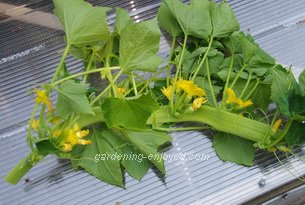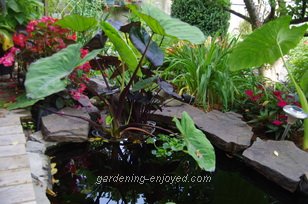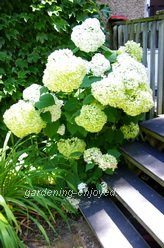| Back to Back Issues Page |
 |
|
Dallying In The Dirt, Issue #181 --- The colocasia filter keeps the river running. August 02, 2014 |

I’ve been working in the garden since early this morning rather then writing “Dallying” because it was supposed to rain this afternoon. Settled into my deck chair late this afternoon, in the deep shade to escape the warm sun, suddenly the sky darkened, the wind blew up and the temperature dropped several degrees in a few moments, I escaped from the deck into the house just in front of the rain. It could have come a little earlier in the afternoon and shortened my hours in the garden, not that I was doing much that was that physical. Having the garden in such great condition for the garden tour has afforded me the delight of actually puttering out there. Water this, fertilize that, prune something else and a fair bit of just wandering around admiring and inquiring what strange and wonderful things Mother Nature can do. Some things are infuriating such as the suddenly dying Eggplant, that has no obvious cause.
The ones farther down the garden appear to be fine. Some things are marvelous. One of the Tuberous Begonias is more than twice the size of its container and has 10 huge salmon coloured blooms that stop visitors in their tracks. Some are just weird. One Cucumber vine, on an obelisk that has eight vines, has developed into a very thick flat stem with multiple flowers at each node and a growth that is much faster than any of its neighbours. I finally cut it out because it was taking over but not producing much fruit. We won’t even discuss the dietary habits of the Rabbits, one of Mother Natures cute but infuriating creations. Every year, about this time, my dietary habits change. I buy a kilo of bacon. Rarely eat the stuff for 10 months of the year but with the arrival of fresh Tomatoes
the bacon and tomato sandwich becomes a constant and delicious part of my diet.  Water that exits the top pond flows down the new river to the middle pond. That river is one of the Grandson’s favourite spots. They break up sticks that they find and float them down the river. Putting them in the river as it leaves the top pond means their boats, (sticks) have to pass through the tunnel under the deck then re-emerge in the new river and float down to the middle pond. They can do this for long periods of time while Grandpa fishes the boats out of the middle pond and re-supplies the boys with another flotilla to make the epic journey. Those ponds and rivers are very clean and clear this year. I occasionally spend some time pulling significant quantities of string algae from the ponds along with the large amounts of dirt that they capture. The boats are put in the top river rather than the top pond because there is an impediment to their passage from the pond to the river. A large basket blocks the passage of water, or little boy’s boats, from the top
pond to the river. That basket contains a couple of Colocasia, whose roots now extend a significant distance into the top pond. The Colocasia thrive in the gravel basket they are anchored in because all of the water must pass over those roots. The water is filled with whatever the fish put into it, and that dilute fish manure supports the great growth of the Colocasia and they return the favour by removing all of that material from the water leaving it clean and clear. We have, this year, achieved the perfect natural balance between fish, algae to feed them, and plants to filter the water. You can look at the ponds and see the bottom some 1.3 M (4') down and almost convince yourself that I had carefully planned it and I will allow you to continue to keep thinking that as I resupply the boys with a renewed flotilla of boats. Who needs mechanical filters when Mother Nature will do the job if you give her just a slight helping hand. Now about those bunnies?
Water that exits the top pond flows down the new river to the middle pond. That river is one of the Grandson’s favourite spots. They break up sticks that they find and float them down the river. Putting them in the river as it leaves the top pond means their boats, (sticks) have to pass through the tunnel under the deck then re-emerge in the new river and float down to the middle pond. They can do this for long periods of time while Grandpa fishes the boats out of the middle pond and re-supplies the boys with another flotilla to make the epic journey. Those ponds and rivers are very clean and clear this year. I occasionally spend some time pulling significant quantities of string algae from the ponds along with the large amounts of dirt that they capture. The boats are put in the top river rather than the top pond because there is an impediment to their passage from the pond to the river. A large basket blocks the passage of water, or little boy’s boats, from the top
pond to the river. That basket contains a couple of Colocasia, whose roots now extend a significant distance into the top pond. The Colocasia thrive in the gravel basket they are anchored in because all of the water must pass over those roots. The water is filled with whatever the fish put into it, and that dilute fish manure supports the great growth of the Colocasia and they return the favour by removing all of that material from the water leaving it clean and clear. We have, this year, achieved the perfect natural balance between fish, algae to feed them, and plants to filter the water. You can look at the ponds and see the bottom some 1.3 M (4') down and almost convince yourself that I had carefully planned it and I will allow you to continue to keep thinking that as I resupply the boys with a renewed flotilla of boats. Who needs mechanical filters when Mother Nature will do the job if you give her just a slight helping hand. Now about those bunnies?At present there are about a dozen baskets containing rhizomes from some wonderful Iris and for a total of $10 anybody can come and have one of each. If I sell enough then the Assistant Gardener will be happier about the dozen new varieties that I have arriving next week. She actually loves the Iris, it’s my financial acumen, or lack thereof, that worries her. Now it’s time to answer a few of my reader’s questions. Don’t forget to check the front page of the Website for frequent short ideas for current gardening activities. Claire Asks? The trees I planted last year still seem to be suffering a bit, should I continue to water them. |
| Back to Back Issues Page |
 At the entrance to the side yard I have inadvertently created an interesting plant. It’s actually two plants that I planted much too close together. Hydrangeas have been the shrub of choice for plant breeders for a few years. One of the first new H. macrophylla introductions was Endless Summer. I planted my sample in a small space near the house at the front of that side yard. A year or so later I planted a Hydrangea, Pinky Winky, a new H. paniculata type, in that same small space. Now they are both thriving with Pinky Winky becoming a small tree over top of the shrubby Endless Summer. The combination was quite accidental, a result of too many plants and too little space to try them all but despite the fact that they are both doing very well, I think I might just leave them commingling for the unusual effect it provides. Several other of the new Hydrangeas that I have tried, produce some wonderful green foliage but not much else but these two have proven
to be reliably consistent bloomers.
At the entrance to the side yard I have inadvertently created an interesting plant. It’s actually two plants that I planted much too close together. Hydrangeas have been the shrub of choice for plant breeders for a few years. One of the first new H. macrophylla introductions was Endless Summer. I planted my sample in a small space near the house at the front of that side yard. A year or so later I planted a Hydrangea, Pinky Winky, a new H. paniculata type, in that same small space. Now they are both thriving with Pinky Winky becoming a small tree over top of the shrubby Endless Summer. The combination was quite accidental, a result of too many plants and too little space to try them all but despite the fact that they are both doing very well, I think I might just leave them commingling for the unusual effect it provides. Several other of the new Hydrangeas that I have tried, produce some wonderful green foliage but not much else but these two have proven
to be reliably consistent bloomers.